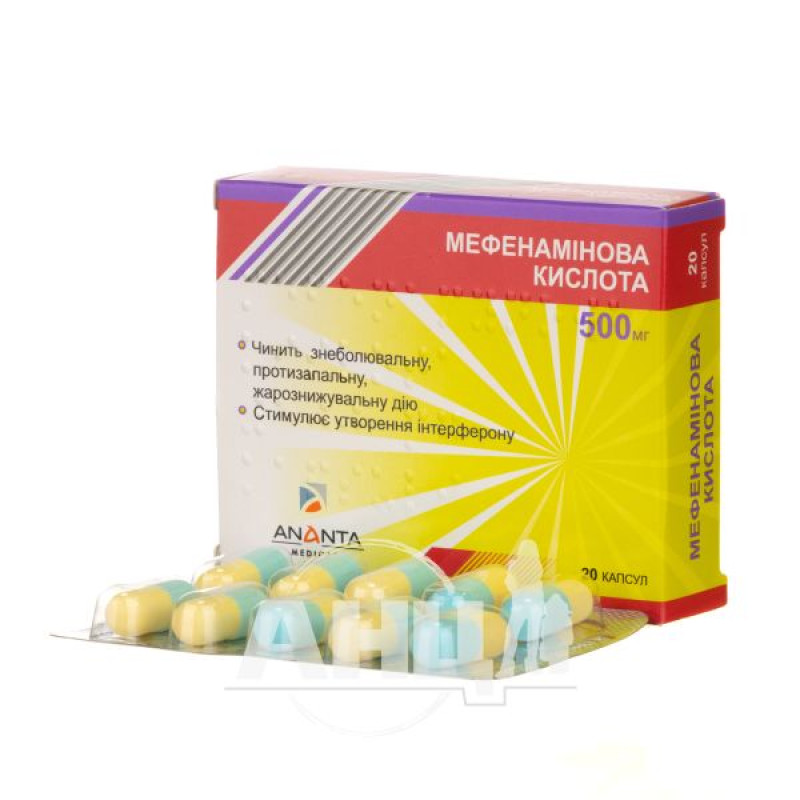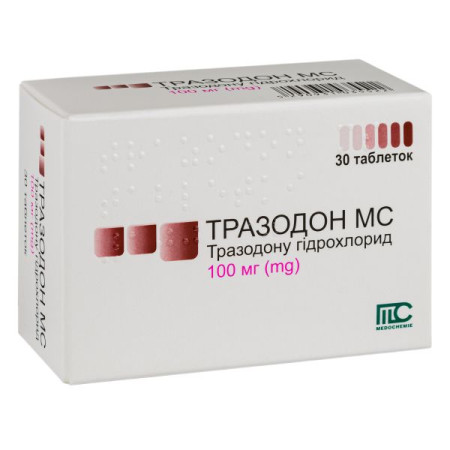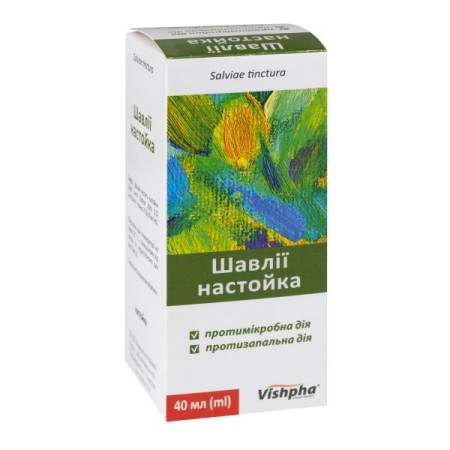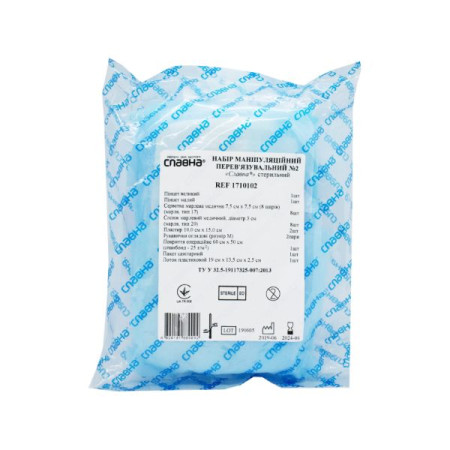Mefenamic acid capsules 500 mg No. 20
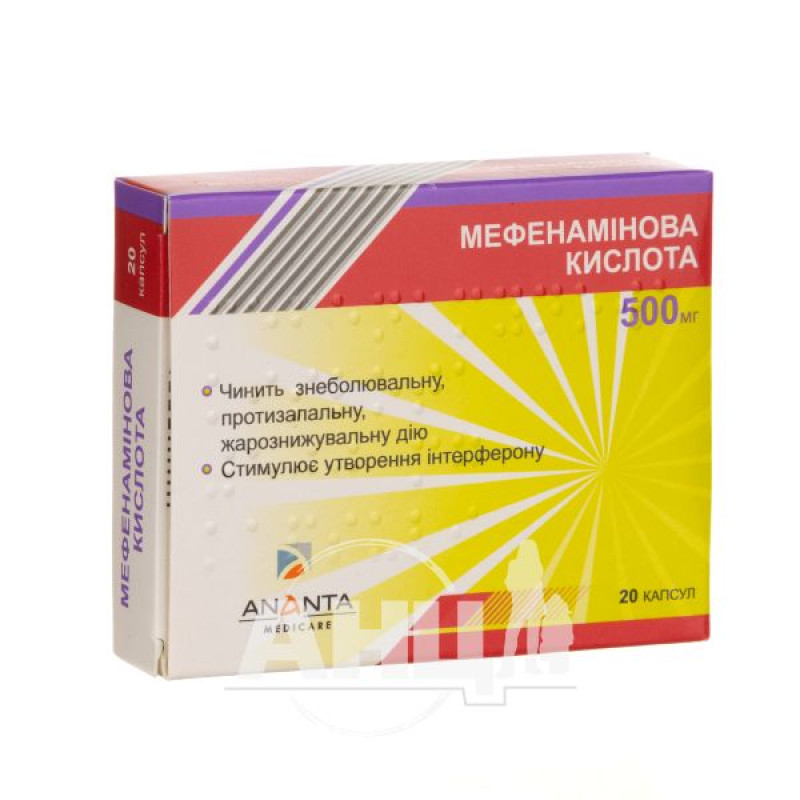
Mefenamic acid capsules are used for the following indications:
Acute respiratory viral infections and influenza. Low and medium intensity pain: muscular, joint, traumatic, dental, headache of various etiologies, postoperative and postpartum pain. Primary dysmenorrhea. Dysfunctional menorrhagia, including those caused by the presence of intrauterine contraceptives, in the absence of pathology of the pelvic organs. Inflammatory diseases of the musculoskeletal system: rheumatoid arthritis, rheumatism, Bechterew's disease.Composition
Active ingredient: mefenamic acid;
1 capsule contains 250 mg or 500 mg of mefenamic acid;
Excipients:
250 mg capsules: talc, lactose monohydrate, corn starch, sodium lauryl sulfate; silicon dioxide; magnesium stearate 500 mg capsules: talc, stearic acid, corn starch, sodium lauryl sulfate, crospovidone.Contraindication
Hypersensitivity to the components of the drug. Bronchospasm, angioedema, rhinitis, bronchial asthma or urticaria in history, which occurred after the use of acetylsalicylic acid or other non-steroidal anti-inflammatory drugs (NSAIDs). Simultaneous reception of specific COX-2 inhibitors. Gastric and duodenal ulcer, including a history, inflammatory bowel diseases, diseases of the blood-forming organs, severe heart failure, severe liver or kidney dysfunction, gastrointestinal bleeding or perforation caused by the use of non-steroidal anti-inflammatory drugs.
Method of application
To use the drug orally, take it after meals.
Adults and children over 12 years of age are prescribed 250-500 mg 3-4 times a day. If necessary, the dose can be increased to 3 g per day. After achieving a therapeutic effect, the daily dose should be reduced to 1 g.
The course of treatment for joint diseases can last from 20 days to 2 months or more. In the treatment of pain syndrome, the course of treatment lasts up to 7 days.
Application features
Pregnant women
The drug is not used in women during pregnancy or breastfeeding.
Children
Recommended for children over 12 years old.
Drivers
Caution should be exercised when driving or operating machinery that requires increased attention, as sometimes the use of the drug can cause drowsiness, blurred vision, and seizures.
Overdose
Symptoms: epigastric pain, nausea, vomiting, drowsiness. In severe cases - gastrointestinal bleeding, respiratory depression, arterial hypertension, twitching of individual muscle groups, coma.
Side effects
From the organs of vision: visual impairment, reversible loss of the ability to distinguish colors, eye irritation. From the organs of hearing and vestibular apparatus: tinnitus, otalgia. From the respiratory system, chest and mediastinal organs: dyspnea, bronchospasm. From the gastrointestinal tract: epigastric pain, anorexia, heartburn, nausea, flatulence, vomiting, enterocolitis, colitis, exacerbation of colitis and Crohn's disease, gastritis, hepatotoxicity, steatorrhea, cholestatic jaundice, hepatitis, pancreatitis, hepatorenal syndrome, hemorrhagic gastritis, peptic ulcer with or without bleeding. Gastrointestinal bleeding, perforation or gastrointestinal bleeding, sometimes fatal, especially in elderly patients, dyspepsia, constipation, diarrhea. From the kidneys and urinary system: dysuria, cystitis. Renal dysfunction, albuminuria, hematuria, oliguria or polyuria, renal failure, including papillary necrosis, acute interstitial nephritis, nephrotic syndrome, allergic glomerulonephritis, hyponatremia, hyperkalemia. Nervous system: drowsiness or insomnia, weakness, irritability, agitation, headache, blurred vision, convulsions, optic neuritis, paresthesia, dizziness, occipital muscle rigidity, fever, disorientation. Psychiatric: confusion, depression, hallucinations. Cardiovascular system: arterial hypertension, arrhythmia, rarely - congestive heart failure, peripheral edema, fainting, arterial hypotension, palpitations, shortness of breath, thrombotic complications (for example, myocardial infarction or stroke). Blood and lymphatic system disorders: aplastic anemia, autoimmune hemolytic anemia, prolonged bleeding time, eosinophilia, leukopenia, thrombocytopenia, decreased hematocrit, thrombocytopenic purpura, agranulocytosis, neutropenia, pancytopenia, bone marrow hypoplasia. Immune system disorders: hypersensitivity reactions including skin rash, pruritus, facial edema, allergic rhinitis, angioedema, laryngeal edema, Stevens-Johnson syndrome, toxic epidermal necrolysis, erythema multiforme, urticaria, bullous pemphigus, photosensitivity, asthma, anaphylaxis. Skin and subcutaneous tissue disorders: purpura, skin rash, pruritus, erythema multiforme, urticaria, bullous pemphigus. Laboratory indicators: impaired glucose tolerance in patients with diabetes mellitus, positive reaction in some tests for the presence of mefenamic acid and its metabolites in bile and urine. Increased levels of liver enzymes in blood plasma.Interaction
Thiamine, pyridoxine hydrochloride, barbiturates, phenothiazine derivatives, narcotic analgesics, caffeine, diphenhydramine increase the analgesic effect of the drug.
Tacrolimus: possible increased risk of nephrotoxic effects.
Storage conditions
Store in the original packaging at a temperature not exceeding 30 °C.
Keep out of reach of children.
Shelf life - 3 years.
There are no reviews for this product.
There are no reviews for this product, be the first to leave your review.
No questions about this product, be the first and ask your question.






